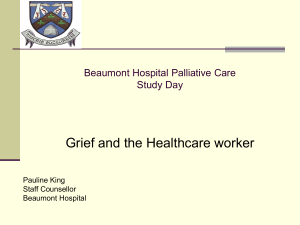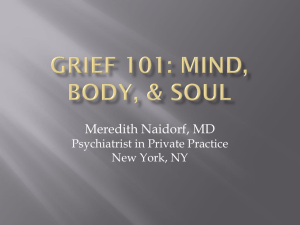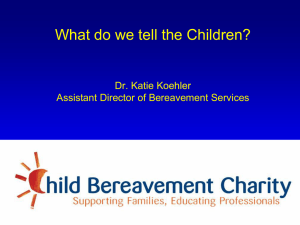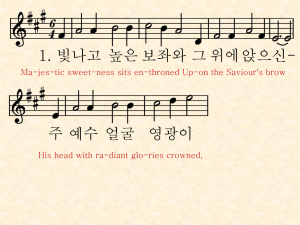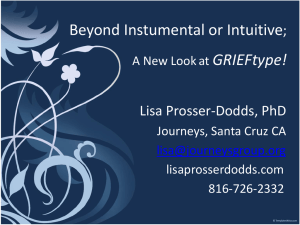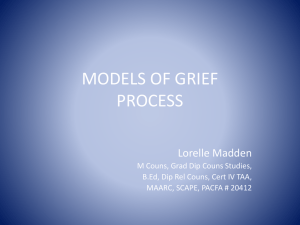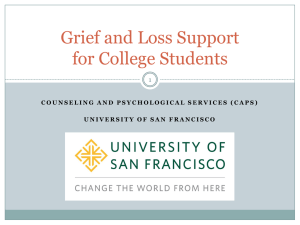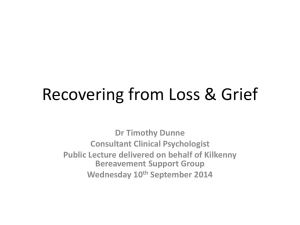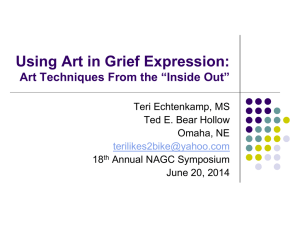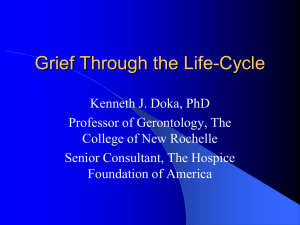Ministry to the Grieving - Bukal Life Care & Counseling Center
advertisement
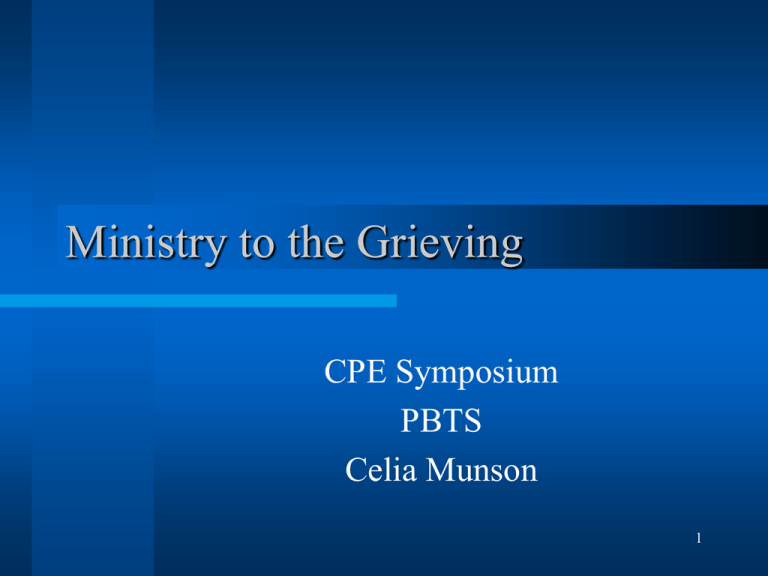
Ministry to the Grieving CPE Symposium PBTS Celia Munson 1 Definitions Crisis: the state of disequilibrium (loss of homeostasis) produced by a perceived threat or adjustment that one finds difficult to handle. Trauma: an event that is outside what is expected in life of an individual that breaks past normal coping and defense mechanism, resulting in strong emotional pain. 2 Definitions Loss: a gradual or sudden removal of something meaningful to an individual. Grief: the intensive emotional suffering caused by loss of someone or something valuable through misfortune or disaster. It is the process of separating from the loss. Suffering: the bearing or undergoing of pain, distress, or injury. 3 Definitions Stress: the entire person’s response – physically, emotionally, socially and spiritually to internal or external demands. The sum total of “wear and tear” on the body Cumulative Stress: stress arousal that slowly builds up over time, sometimes leading to a condition of “burnout” Eustress: a positive motivating force that may lead to increase of health and performance Distress: a negative dysfunctional force that may lead to disease and erosion of health. 4 Key Concepts “Crisis can happen without trauma but when there is trauma, crisis always happens” “Crisis is always linked with stress” “Crisis always leads to loss” 5 4 Types of Losses Real or Concrete Losses Abstract Losses Imagined Losses Threatened Losses 6 3 Types of Grief Anticipatory Grief Acute Grief Chronic Grief 7 Grief is… …A normal healthy response for anyone who has experienced the loss of something or someone they have valued or have had an emotional investment. 8 Common Clichés [Linn, (1986)] Exhort people to be strong: “ The person who died wouldn’t want you to cry” Want people to hurry up their grief: “ Life goes on” Increase guilt about how people grieve: “ You aren’t counting your blessings” Suggest religion should comfort: “God never gives you more than you can handle” Discount and minimize: “ I know just how you feel” 9 Common Myths Don’t Grieve Grief Harms our Faith Always be Positive God is Absent if You Grieve 10 Movements of Grief as a Healing Journey #1 Joining “It is completely normal to long for those you love, and weep over their absence. It reveals our Christ-like nature of compassion, love, empathy and concern for others.” 11 Movements of Grief as a Healing Journey #2 Normalizing Stormy Emotions There are “numerous stages through which the bereaved must travel through in order to resolve their loss.” 12 Steps of Grief [Kubler-Ross, 1969] Denial Anger Bargaining Depression Acceptance [Can vary person-to-person and culture-to-culture] 13 Movements of Grief as a Healing Journey #3 Understanding “What can I learn from this and how can I best proceed with my life?” “We also realize that grieving is a twopart process: the loss of a loved one, and the recovery of our spirit.” 14 Movements of Grief as a Healing Journey #4 Surrender “… we finally accept that we could not have changed our loved one’s death. We accept that we are unable to turn back the hand of time– we cannot bring them back nor are they coming back.” 15 Movements of Grief as a Healing Journey #5 Praise, Again “How does one move beyond pain to the point of praise? It is impossible by our own strength; but miracles happen when we ask God to empower us.” 16 Complicated Grief Preoccupation with yearning for, and searching for the deceased Intrusive images, ideas, recurrent dreams/nightmares Active avoidance of thoughts, communication, or action associated with the loss Interference with daily functioning Persistent symptoms (Ogrodniczuk, 2003) 17 Risk Factors History of difficult relationship Challenging circumstances of the death Intensity of grief reactions, both in anticipatory grief and bereavement Poor quality of support network as perceived by bereaved person History of unresolved losses (e.g. grief, abuse, abandonment) 18 Risk Factors (cont’d) Concurrent stresses (e.g. job or relationship difficulties, other caregiving roles, financial distress) Multiple losses History of drug or alcohol use History of illness, mental health issues, developmental problems (Cairns, Johnson,& Wainwright, 1993) 19 10 Commandments on Dealing With Stress <HANDOUT> 20 Ways to Cope After a Trauma <HANDOUT> 21 Holmes-Rahe Stress Test <HANDOUT> 22 “HELP US TO BE THE ALWAYS HOPEFUL GARDENERS OF THE SPIRIT, WHO KNOW THAT WITHOUT DARKNESS NOTHING COMES TO BIRTH AS WITHOUT LIGHT NOTHING FLOWERS.” -MAY SARTON (1993) 23 Bibliography Augsberger, David. Pastoral Counseling Across Cultures, 1986. Cairns, M., Thompson, M., Wainwright, W. (2003) Transitions in Dying & Bereavement. Baltimore: Health Professional Press Clinton, Tim and George Ohlschlager, “The Movements of Grief as a Healing Journey”. Christian Counseling Today. 2003 Vol. 11 #2, 16-22. Won, Chiyon. Class Notes for “Crisis Counseling” Class. Philippine Baptist Theological Seminary, 2006. 24
